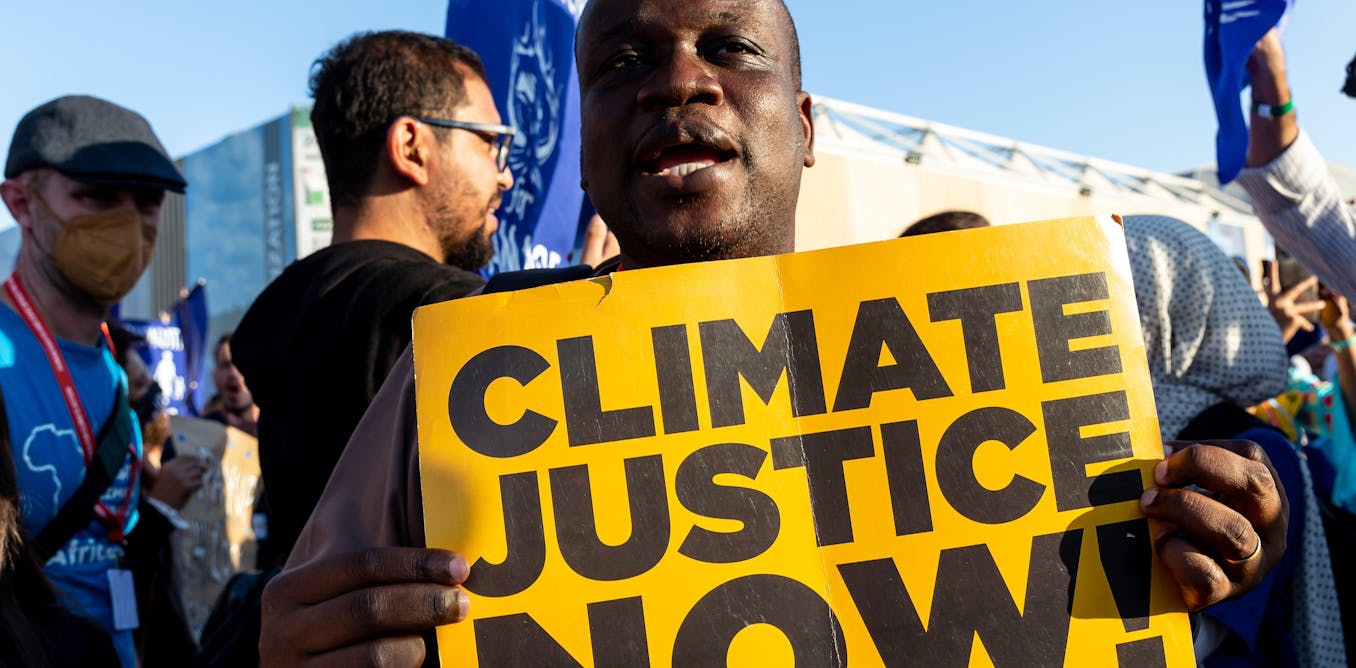
Climate change: why a new insurance scheme for vulnerable countries is a bad idea
The new Global Shield won’t work as ultimately rich countries and companies must foot the bill.
Nov. 16, 2022 • 8 min • Source
Climate breakdown is well under way. So it is no wonder that a defining conflict of the COP27 climate talks in Sharm-el-Sheikh, Egypt is over who pays for the damages that are already taking place, and how.
Earlier this year the V20 – a grouping of poor countries most vulnerable to climate change – estimated that the costs to its members of the climate crisis had already surpassed US$500 billion. It called for the establishment of an international “loss and damage” fund, paid for by the “rich, powerful and climate change-responsible nations”. Initial proposals for financing the fund included a global carbon tax, taxes on airline travel, windfall taxes on fossil fuel producers, or taxes on financial transactions.
The response, favoured by most rich countries, has been to instead promote the development of new insurance schemes protecting against climate damages. Germany has led the way and formally launched with the V20 and G7 an insurance-based “Global Shield against Climate Risks” on November 14.
Details are still emerging. However, Global Shield looks to have walked back the more expressly redistributive proposals initially advanced by the V20. It is also significantly more restrictive than proposals for a global “Loss and Damage” fund advanced by China and the G77 bloc of developing countries.
The major thrust of Global Shield is to increase “pre-arranged” finance “which disburses quickly and reliably before or just after disasters happen”. It aims to do this by supporting the development of a range of different insurance instruments at household, business and national level.
Initial funding comes mostly from Germany, which has pledged €170 million, with smaller pledges from Canada, Denmark, France and Ireland. The G20, World Bank and V20 have all pledged to help with its administration.
Global Shield is far from the first experiment with insurance as a response to the increasing prevalence of climate hazards. There are important reasons, highlighted extensively by previous research, to be very cautious about the limits of insurance as a climate response. Two particular problems will be very difficult for Global Shield to surmount: who pays? And which risks can be covered?
Who pays?
The first problem is who pays for insurance coverage. This is an ethical problem: should the people and countries who’ve contributed least to greenhouse gas emissions pay the cost of the associated damages? But it’s also a pragmatic limit encountered by most previous insurance schemes for climate risks.
For the past quarter century, the World Bank and other institutions have promoted household- and business-level insurance schemes for the poorest as a response to climate risks. In practice, these schemes have often proved too expensive for poor people to sign up to. Existing schemes remain heavily reliant on public subsidies.
National-scale insurance faces similar problems. For instance, the African Risk Capacity (ARC), a famine-relief scheme launched in 2014 by the African Union, has never managed to enrol more than 13 of 54 eligible countries.
It’s not clear yet who will pay for insurance under Global Shield. Judging by the size of the financial commitments announced thus far, it seems fair to say that major donors don’t intend to pay for all of it.
But some form of premium support from donors will be a condition for Global Shield to get off the ground. This is especially true given the escalating debt burdens currently faced by many developing countries. Yet, even with premiums partially subsidised by donors, the experience of the African Risk Capacity and of individual- and household-level schemes over the last couple of decades isn’t promising.
Equally, it’s unclear whether poor people and countries should have to pay at all. Asking the people who’ve contributed least to global carbon emissions to pay for protection from the effects of those emissions is precisely the inverse of most visions of climate justice.
Protection from what risks?
By definition, insurance is designed to protect against singular harmful events which must be relatively rare. Global Shield is clearly designed with such catastrophes in mind – things like flooding, storms and severe droughts.
It is highly questionable whether this “rarity” condition will be met, given the increasing frequency of natural disasters. As Harjeet Singh of the Climate Action Network pointed out: “If I get into car accidents every other day, I will be blacklisted by the company.”

Equally, it can be difficult to determine if weather events are severe enough to trigger a payout. This is even harder when funds are meant to be disbursed in advance or very quickly – as Global Shield aims to do. There’s a risk that countries or people buy insurance, but then find that it doesn’t cover the precise disaster they’re faced with.
For instance, in 2016 a severe drought in Malawi caused a famine, but failed to trigger a payout from ARC. The scheme used a predictive model which underestimated the extent of likely damage. Eventually, adjustments were made and US$8 million paid to Malawi. But this happened months too late, and made no more than a small dent in the estimated US$395 million in damages caused by the drought.
There’s another problem. Insurance, by definition, can only offer cover against specific events. It is very little help with, say, the gradual erosion of the ecological conditions suitable for producing key crops. This is arguably the main form in which the most vulnerable people experience climate damage.
Recent research on rice farmers in Cambodia, for instance, has shown many farmers trapped in a spiral of escalating indebtedness linked to climate change. Unpredictable rainfall had led to growing reliance on costly fertilisers and pesticides, as well as exposure to increasingly frequent crop failures.

Campaigners have already described Global Shield as “cynical” and a “distraction” from meaningful efforts to fund loss and damage. Whatever the motivations of the German government and its other supporters, the track record of various initiatives aimed at using insurance to address climate risks should give us pause.
We have to meaningfully address the escalating loss and damage already underway due to climate change. There is probably no adequate alternative to rich countries and powerful companies footing the bill.

Don’t have time to read about climate change as much as you’d like?
Get a weekly roundup in your inbox instead. Every Wednesday, The Conversation’s environment editor writes Imagine, a short email that goes a little deeper into just one climate issue. Join the 10,000+ readers who’ve subscribed so far.
Nick Bernards does not work for, consult, own shares in or receive funding from any company or organisation that would benefit from this article, and has disclosed no relevant affiliations beyond their academic appointment.
